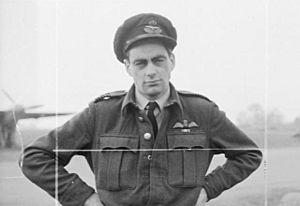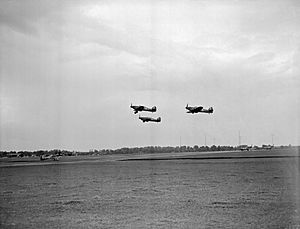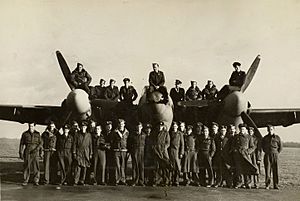Irving Smith (RAF officer) facts for kids
Quick facts for kids
Irving Smith
|
|
|---|---|

Irving Smith, commander of No. 487 (NZ) Squadron
|
|
| Nickname(s) | Black |
| Born | 21 May 1917 Invercargill, New Zealand |
| Died | 16 February 2000 (aged 82) Devon, England |
| Allegiance | New Zealand |
| Service/ |
Royal New Zealand Air Force (1939–1945) Royal Air Force (1945–1966) |
| Rank | Group Captain |
| Commands held | RAF Jever RAF Church Fenton No. 56 Squadron No. 487 (NZ) Squadron No. 151 Squadron |
| Battles/wars | Second World War |
| Awards | Commander of the Order of the British Empire Distinguished Flying Cross & bar Mention in despatches |
Irving Stanley Smith (21 May 1917 – 16 February 2000) was a brave New Zealand pilot. He was a "flying ace" during the Second World War. This means he shot down at least five enemy aircraft. He flew for the Royal New Zealand Air Force (RNZAF) and later the Royal Air Force (RAF). He destroyed eight enemy planes in total.
Irving Smith was born in Invercargill, New Zealand. He joined the RNZAF in 1939. He then went to England for flight training. He flew Hawker Hurricane planes during the Battle of Britain. Later, his squadron became night fighters during the Blitz. By 1942, he was leading his squadron.
In 1944, he became the commander of No. 487 (NZ) Squadron. He led them during important missions. These included Operation Jericho and air support for the D-Day landings. After the war, he joined the RAF permanently. He worked in different flying and leadership roles. He retired in 1966 and later became a farmer in Devon, England. He passed away in 2000 at 82 years old.
Contents
Early Life and Training
Irving Stanley Smith was born on 21 May 1917 in Invercargill, New Zealand. His family later moved to Whangārei. He went to Whau Valley School and Whangarei Boys' High School. Before joining the military, he worked as a painter in Auckland.
In January 1939, he was accepted into the Royal New Zealand Air Force. He started his flight training in May at Māngere. Soon after, he went to England to continue his training with the Royal Air Force.
Second World War Missions
When the Second World War began in September 1939, Smith was still training. He learned to fly Tiger Moth planes. By July 1940, he had finished his training. He was then sent to the RAF's No. 151 Squadron. This unit was based at North Weald and flew Hawker Hurricane fighter planes.
Battle of Britain Heroics
During the Battle of Britain, No. 151 Squadron defended England. They often flew over the Thames Estuary. Their job was to stop German bombers from reaching their targets. On 15 August, Smith shot down two Messerschmitt Bf 109 fighters. He also damaged another Bf 109.
A week later, on 24 August, he destroyed a Heinkel He 111 bomber. On 31 August, he flew four missions. In one, he destroyed a Dornier Do 17 bomber. He also damaged another Do 17. After these intense battles, his squadron moved to Digby for a rest.
Many experienced pilots had been lost. New pilots joined the squadron. Smith and other veterans helped train them. On 2 October, Smith was on a training flight. He spotted a German bomber that had just attacked a factory. He chased it into a cloud. Flying by instruments, he fired at the bomber. He then saw it falling with a damaged engine. He attacked again, and the bomber crashed into the water. Its crew swam to shore.
Night Fighting During the Blitz
By November, German planes were bombing at night more often. So, No. 151 Squadron became a night-fighting unit. They used Boulton Paul Defiant planes. Smith commanded a group of Hurricanes that stayed with the squadron. They protected the Midlands region from their base at Wittering.
On 7 March 1941, Smith received the Distinguished Flying Cross (DFC). This award is for bravery in air combat. He was nicknamed 'Black' to tell him apart from another pilot named Smith.
During a huge raid on London on 10 May, Smith shot down a He 111. This was his first night victory. By mid-1941, he was promoted to acting flight lieutenant. He led a combined group of Defiants and Hurricanes.
On 19 February 1942, Smith became acting squadron leader. He took command of No. 151 Squadron. That same day, he led his squadron to protect a convoy. He helped his gunner shoot down a Do 17 and damage a Junkers Ju 88. In April, the squadron started using de Havilland Mosquito planes. By the end of May, Smith was promoted to acting wing commander. On 24 June, he destroyed a He 111 and a Do 217. He likely destroyed another He 111 that same night. In July, he received a bar to his DFC. This meant he had earned the award a second time.
Leading No. 487 (NZ) Squadron
In March 1943, Smith worked at Fighter Command headquarters. But he wanted to return to flying missions. In February 1944, he got his wish. He became commander of No. 487 (NZ) Squadron. This squadron also flew Mosquito planes. They were based at Hunsdon. They started flying night missions, attacking enemy airfields in France and Holland.
Soon after Smith arrived, his wing was given a secret mission called Operation Jericho. The goal was to bomb the walls of a prison in Amiens. This would help over 100 members of the French Resistance escape. Many of them were sentenced to death. On 18 February, Smith led seven Mosquitos from his squadron. They were the first to attack the prison. They successfully broke the east and north walls with their bombs. Other squadrons then attacked the prison buildings, allowing prisoners to escape. German fighters tried to stop them, but all of Smith's planes returned safely. Many resistance fighters and other prisoners gained their freedom.
Because of his leadership, Smith briefly commanded the entire 140 Mosquito Wing. In May, his squadron moved to support the invasion of Normandy. They continued to attack German airfields at night. In the six weeks before D-Day, they flew 30 missions without losing a single plane. During the day, they attacked German missile sites and transport routes. On the night before D-Day, they bombed targets in Caen and Saint-Lô. After D-Day, they helped destroy German forces moving towards the Allied beachhead in Normandy. By the end of August, when Smith left the squadron, they had flown over 900 missions.
End of the War
After leaving No. 487 Squadron, Smith became an instructor. He trained new Mosquito crews. He stayed in this role until the war ended. By the end of the war, he was credited with destroying eight enemy aircraft. He also probably destroyed one and damaged four others. After the war in Europe ended, he officially joined the RAF. He was given the rank of squadron leader. He was also mentioned in official reports for his bravery.
Postwar Service and Retirement
In 1946, Smith attended the RAF Staff College in Haifa. Later that year, he worked at Air Headquarters in Malta. In 1948, he returned to the United Kingdom for more staff training.
In 1950, he became commander of No. 56 Squadron. This squadron flew Gloster Meteor jet planes. By mid-1950, he was a wing commander. In January 1952, he became the station commander at Church Fenton. That year, he was made an Officer of the Order of the British Empire.
From 1953 to 1956, Smith worked at Fighter Command headquarters. Then, he went to the United States for an exchange program with the United States Air Force. He attended a staff college and served at Tactical Air Command. He returned to the UK in 1958. He was promoted to group captain that August. He then took command of the RAF base at Jever in Germany. In 1961, he was made a Commander of the Order of the British Empire. He later worked at Signals Command. In 1964, he attended the National Defence College in Canada.
Later Life
Irving Smith retired from the RAF in February 1966 due to health reasons. He settled in Devon, England, and became a farmer. He passed away on 16 February 2000. His wife, Joan, who was an officer in the Women's Auxiliary Air Force, had passed away before him. They married in London in 1942. One of his two daughters also passed away before him. His son, Rupert Smith, became a general in the British Army. He served in a high position at NATO headquarters.



